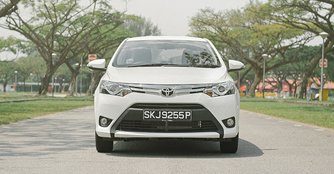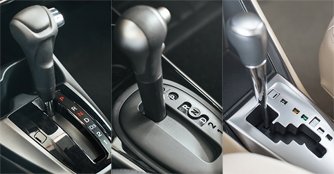Toyota Vios 1.5 G (A) vs Nissan Almera 1.5 Premium (A) vs Honda City 1.5 (A)
19 Jun 2013|123,113 views
What used to be affordable and sugar sweet bread-and-butter cars have become way pricier and perhaps a little too bitter for your usual taste bud. While pricing of cars has been constantly changing - with whatever new rules and regulations - the mission of these cars don't.
When it comes down to the crunch, these cars will accomplish their motoring mission without fuss and will make even the regular driver feel fantastic about his ride. And that's not to say these cars can't add a wee bit of fun into their functionality nature. Needless to say, the cars we have here today are the very definition of the said description.
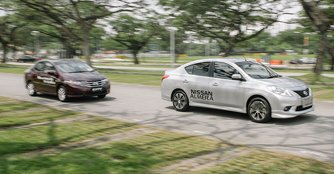
 More than just a beauty contest - these compact sedans need to outbeat each other in terms of bang-for-buck
More than just a beauty contest - these compact sedans need to outbeat each other in terms of bang-for-buck
The recently launched Toyota Vios has been a hot seller in Singapore since its debut in 2007. Put together in Thailand (like the other two cars here), the Vios has gone through several changes but hasn't lost its essence: simple, practical and humble. More importantly, keeping its reliability trademark has made it one of the top car choices in Singapore.
The Nissan Almera landed here in the last quarter of 2011. While not as popular as the Vios, the car has a very strong backing, coming from the brand that gave us the GT-R and the 370Z. More relevantly, it has a strong proposition - space. Roomy, refined and reliable, the Nissan Almera is the perfect choice of compact sedan for people who want more car for less money.
The Honda City began life a long, long time ago in 1981. The fifth generation Honda was unveiled in Thailand in 2008 before going through a facelift in 2012. This City, as a result, has an updated chrome grille, new front and rear bumpers, new taillamps design, new alloy wheels and an eco-driving indicator.
But which of these compact sedans can give you the most car for the least amount of money?
When it comes down to the crunch, these cars will accomplish their motoring mission without fuss and will make even the regular driver feel fantastic about his ride. And that's not to say these cars can't add a wee bit of fun into their functionality nature. Needless to say, the cars we have here today are the very definition of the said description.

The recently launched Toyota Vios has been a hot seller in Singapore since its debut in 2007. Put together in Thailand (like the other two cars here), the Vios has gone through several changes but hasn't lost its essence: simple, practical and humble. More importantly, keeping its reliability trademark has made it one of the top car choices in Singapore.
The Nissan Almera landed here in the last quarter of 2011. While not as popular as the Vios, the car has a very strong backing, coming from the brand that gave us the GT-R and the 370Z. More relevantly, it has a strong proposition - space. Roomy, refined and reliable, the Nissan Almera is the perfect choice of compact sedan for people who want more car for less money.
The Honda City began life a long, long time ago in 1981. The fifth generation Honda was unveiled in Thailand in 2008 before going through a facelift in 2012. This City, as a result, has an updated chrome grille, new front and rear bumpers, new taillamps design, new alloy wheels and an eco-driving indicator.
But which of these compact sedans can give you the most car for the least amount of money?
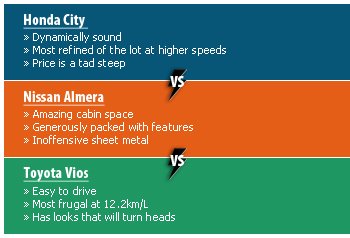 |
Exterior
The revamped Vios has a sheet metal that's very pleasing to the eye. 'Modern' and 'contemporary' are two very apt words to describe this car. The car is also longer than before, growing from 4,300mm to 4,410mm. As a result, it has more road presence than before.
The Almera keeps up with the competition with its modern and inoffensive looks. And it's precisely this look that, somehow, has the pulling influence of drawing praises. But more impressively, the Almera (Premium variant) is the only car of the pack that comes with a keyless entry system. It is also the only contender that comes with 16-inch wheels (the other two came with 15s) as standard.
The Honda City, on the other hand, has a dated look when compared to the other two contenders. Perhaps colours play a part in this. The white Vios and silver Almera outshine the dark maroon City. Where it excels, though, is its dynamic sheet metal, thanks to sharp and bold lines that are found missing in the other two jolly Japanese.
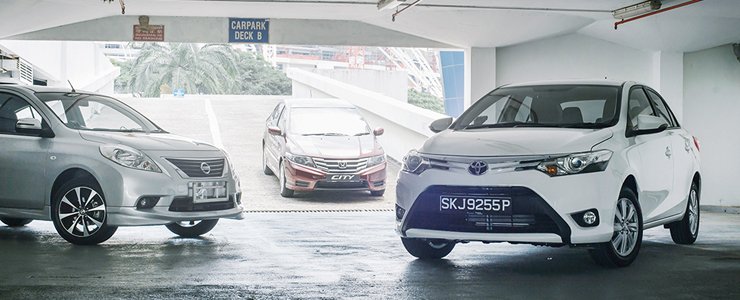 |
Interior
Like its predecessor, the cabin of the Vios is filled with solid two-tone plastics, which give you the impression that it'll stay that way for the next decade without eroding or falling apart. The driver's seat is sufficiently bolstered and has a high seating position - a definite advantage for short farts like this writer. The Vios also sports quality buttons and digital climate controls and audio controls on the steering wheel.
In terms of space, the Vios has sufficient head and legroom all round for five occupants. The fact that it's missing a transmission tunnel helps a lot in this aspect too. Boot space stands at 476 litres - commodious enough for a family picnic. Space can be further expanded to 506 litres with the 60:40 foldable rear seats.
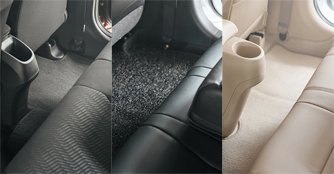
 The Almera (centre) offers the roomiest rear quarters, with the Vios (right) close behind, followed by the City (left)
The Almera (centre) offers the roomiest rear quarters, with the Vios (right) close behind, followed by the City (left)
The Nissan Almera isn't far behind. While the all-black cabin wasn't to our liking, it keeps up with quality plastic materials and piano black trims. The driver's bench is comfortable, but it does offer a rather awkward seating position. Like the Vios, the Almera has digital climate controls to better its cabin atmosphere and audio controls on the steering wheel.
Like its predecessor, the cabin of the Vios is filled with solid two-tone plastics, which give you the impression that it'll stay that way for the next decade without eroding or falling apart. The driver's seat is sufficiently bolstered and has a high seating position - a definite advantage for short farts like this writer. The Vios also sports quality buttons and digital climate controls and audio controls on the steering wheel.
In terms of space, the Vios has sufficient head and legroom all round for five occupants. The fact that it's missing a transmission tunnel helps a lot in this aspect too. Boot space stands at 476 litres - commodious enough for a family picnic. Space can be further expanded to 506 litres with the 60:40 foldable rear seats.

The Nissan Almera isn't far behind. While the all-black cabin wasn't to our liking, it keeps up with quality plastic materials and piano black trims. The driver's bench is comfortable, but it does offer a rather awkward seating position. Like the Vios, the Almera has digital climate controls to better its cabin atmosphere and audio controls on the steering wheel.
Space wise, the Almera comes out top. With the longest wheelbase of the trio at 2,590mm, the Nissan compact sedan has more than adequate room for five occupants. Rear passengers can even have the choice of sitting cross-legged here. At 490 litres, the boot space is rather generous as well. Only problem is the Almera doesn't come with 60:40 foldable rear benches.
The Honda City, unfortunately, is slightly more inadequate. It doesn't come with digital climate controls and you'd be slightly disappointed by the absence of steering-mounted controls too.
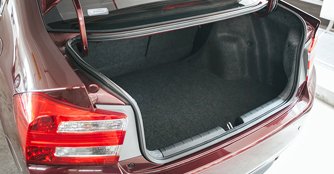
 The City may dull in terms of cabin space, but it makes up for it with the biggest boot of 506 litres
The City may dull in terms of cabin space, but it makes up for it with the biggest boot of 506 litres
While legroom may not be the best, it betters both the Vios and Almera with its luggage capacity. At 506 litres, the City has the biggest boot space. Rear seats can also be knocked down to fit longer items.
The Honda City, unfortunately, is slightly more inadequate. It doesn't come with digital climate controls and you'd be slightly disappointed by the absence of steering-mounted controls too.

While legroom may not be the best, it betters both the Vios and Almera with its luggage capacity. At 506 litres, the City has the biggest boot space. Rear seats can also be knocked down to fit longer items.
 |
The Drive
The Vios is rather perky on the move. Mated to a four-speed automatic gearbox, the 1.5-litre engine is a little harsh when moving off the line. But once up to speed, the Vios is comfortable and composed. It's not sluggish either. With 107 horses and 141Nm of torque sent to the front wheels, the Vios will complete the century sprint in a respectable 12 seconds.
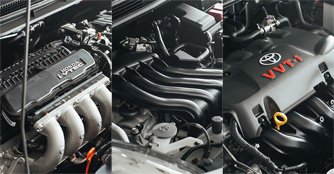
 City (left) most punchy with 120bhp and 145Nm of torque; Vios (right) feel adequate with 107bhp and 141Nm of torque; Almera (centre) a tad sluggish at 99bhp and 134Nm of torque
City (left) most punchy with 120bhp and 145Nm of torque; Vios (right) feel adequate with 107bhp and 141Nm of torque; Almera (centre) a tad sluggish at 99bhp and 134Nm of torque
It's also very easy to have fun in this car. The Vios is not what you'd call a driver's car but chucking it into corners can be surprisingly entertaining. It has ample grip with a fair bit of understeer if you decide to brake late into the corner.
The Almera has no qualms keeping up with the Vios. Mated to a four-speed autobox, the 1.5-litre four-pot engine will churn out 99 horses and 134Nm of torque. Although it takes 13.7 seconds to get to the 100km/h mark, it feels faster than that in real world driving conditions. The Almera, just like the Vios, feels a tad harsh when pushed. But once up to highway speeds, the car remains as a refined ride.
Round corners, the Almera is slightly sluggish, with evident body roll. That said, it is reasonably direct, exuding a sense of agility, if not accuracy.
The Honda City does well on the go. It's the most refined of the lot, even at high revs, with credit going to the extra cog. This five-speed automatic teams up well with the 1.5-litre i-VTEC engine to deliver 120 horses and 145Nm of torque to the front wheels. As such, it takes 12 seconds to complete the 0-100km/h sprint.
The Vios is rather perky on the move. Mated to a four-speed automatic gearbox, the 1.5-litre engine is a little harsh when moving off the line. But once up to speed, the Vios is comfortable and composed. It's not sluggish either. With 107 horses and 141Nm of torque sent to the front wheels, the Vios will complete the century sprint in a respectable 12 seconds.

It's also very easy to have fun in this car. The Vios is not what you'd call a driver's car but chucking it into corners can be surprisingly entertaining. It has ample grip with a fair bit of understeer if you decide to brake late into the corner.
The Almera has no qualms keeping up with the Vios. Mated to a four-speed autobox, the 1.5-litre four-pot engine will churn out 99 horses and 134Nm of torque. Although it takes 13.7 seconds to get to the 100km/h mark, it feels faster than that in real world driving conditions. The Almera, just like the Vios, feels a tad harsh when pushed. But once up to highway speeds, the car remains as a refined ride.
Round corners, the Almera is slightly sluggish, with evident body roll. That said, it is reasonably direct, exuding a sense of agility, if not accuracy.
The Honda City does well on the go. It's the most refined of the lot, even at high revs, with credit going to the extra cog. This five-speed automatic teams up well with the 1.5-litre i-VTEC engine to deliver 120 horses and 145Nm of torque to the front wheels. As such, it takes 12 seconds to complete the 0-100km/h sprint.
It's also the most dynamically sound in the handling department. Round corners, body roll is well controlled, with a rather precise steering. Although it can do with more feedback, the City is most suited for curvy roads.
Conclusion
The Toyota Vios has always been the hero in its segment and it's not going to be any different this time. At 12.2km/L during our time with the car, the Vios is economical, easy to pilot and has looks that will easily turn heads. It's simply a car that every man, woman, boy and girl can drive without having too much to worry.
The Nissan Almera is a car that will put a smile on regular drivers' faces with its reliability and an even bigger smile on passengers' faces with its ridiculously generous space. At 11km/L during our test drive, the Almera is just as economical as the Vios. It may not be exciting to drive, but it gets the job done effortlessly.
The fact that the Honda City can stand out in this comparison test clearly demonstrates its capabilities. It has evolved from one backward looking car to what it is today and for that, the car deserves credit. But costing $6,000 more than the Vios and $16,000 more than the Almera, the City can be a tad steep in its price, even if it's economical at 11.3km/L.
The Toyota Vios may emerge as the winner for this test, but one thing is for sure - the Nissan Almera and the Honda City are definitely worthy runner-ups.
Conclusion
The Toyota Vios has always been the hero in its segment and it's not going to be any different this time. At 12.2km/L during our time with the car, the Vios is economical, easy to pilot and has looks that will easily turn heads. It's simply a car that every man, woman, boy and girl can drive without having too much to worry.
The Nissan Almera is a car that will put a smile on regular drivers' faces with its reliability and an even bigger smile on passengers' faces with its ridiculously generous space. At 11km/L during our test drive, the Almera is just as economical as the Vios. It may not be exciting to drive, but it gets the job done effortlessly.
The fact that the Honda City can stand out in this comparison test clearly demonstrates its capabilities. It has evolved from one backward looking car to what it is today and for that, the car deserves credit. But costing $6,000 more than the Vios and $16,000 more than the Almera, the City can be a tad steep in its price, even if it's economical at 11.3km/L.
The Toyota Vios may emerge as the winner for this test, but one thing is for sure - the Nissan Almera and the Honda City are definitely worthy runner-ups.
What used to be affordable and sugar sweet bread-and-butter cars have become way pricier and perhaps a little too bitter for your usual taste bud. While pricing of cars has been constantly changing - with whatever new rules and regulations - the mission of these cars don't.
When it comes down to the crunch, these cars will accomplish their motoring mission without fuss and will make even the regular driver feel fantastic about his ride. And that's not to say these cars can't add a wee bit of fun into their functionality nature. Needless to say, the cars we have here today are the very definition of the said description.
The recently launched Toyota Vios has been a hot seller in Singapore since its debut in 2007. Put together in Thailand (like the other two cars here), the Vios has gone through several changes but hasn't lost its essence: simple, practical and humble. More importantly, keeping its reliability trademark has made it one of the top car choices in Singapore.
The Nissan Almera landed here in the last quarter of 2011. While not as popular as the Vios, the car has a very strong backing, coming from the brand that gave us the GT-R and the 370Z. More relevantly, it has a strong proposition - space. Roomy, refined and reliable, the Nissan Almera is the perfect choice of compact sedan for people who want more car for less money.
The Honda City began life a long, long time ago in 1981. The fifth generation Honda was unveiled in Thailand in 2008 before going through a facelift in 2012. This City, as a result, has an updated chrome grille, new front and rear bumpers, new taillamps design, new alloy wheels and an eco-driving indicator.
But which of these compact sedans can give you the most car for the least amount of money?
When it comes down to the crunch, these cars will accomplish their motoring mission without fuss and will make even the regular driver feel fantastic about his ride. And that's not to say these cars can't add a wee bit of fun into their functionality nature. Needless to say, the cars we have here today are the very definition of the said description.
The recently launched Toyota Vios has been a hot seller in Singapore since its debut in 2007. Put together in Thailand (like the other two cars here), the Vios has gone through several changes but hasn't lost its essence: simple, practical and humble. More importantly, keeping its reliability trademark has made it one of the top car choices in Singapore.
The Nissan Almera landed here in the last quarter of 2011. While not as popular as the Vios, the car has a very strong backing, coming from the brand that gave us the GT-R and the 370Z. More relevantly, it has a strong proposition - space. Roomy, refined and reliable, the Nissan Almera is the perfect choice of compact sedan for people who want more car for less money.
The Honda City began life a long, long time ago in 1981. The fifth generation Honda was unveiled in Thailand in 2008 before going through a facelift in 2012. This City, as a result, has an updated chrome grille, new front and rear bumpers, new taillamps design, new alloy wheels and an eco-driving indicator.
But which of these compact sedans can give you the most car for the least amount of money?
Exterior
The revamped Vios has a sheet metal that's very pleasing to the eye. 'Modern' and 'contemporary' are two very apt words to describe this car. The car is also longer than before, growing from 4,300mm to 4,410mm. As a result, it has more road presence than before.
The Almera keeps up with the competition with its modern and inoffensive looks. And it's precisely this look that, somehow, has the pulling influence of drawing praises. But more impressively, the Almera (Premium variant) is the only car of the pack that comes with a keyless entry system. It is also the only contender that comes with 16-inch wheels (the other two came with 15s) as standard.
The Honda City, on the other hand, has a dated look when compared to the other two contenders. Perhaps colours play a part in this. The white Vios and silver Almera outshine the dark maroon City. Where it excels, though, is its dynamic sheet metal, thanks to sharp and bold lines that are found missing in the other two jolly Japanese.
Interior
Like its predecessor, the cabin of the Vios is filled with solid two-tone plastics, which give you the impression that it'll stay that way for the next decade without eroding or falling apart. The driver's seat is sufficiently bolstered and has a high seating position - a definite advantage for short farts like this writer. The Vios also sports quality buttons and digital climate controls and audio controls on the steering wheel.
In terms of space, the Vios has sufficient head and legroom all round for five occupants. The fact that it's missing a transmission tunnel helps a lot in this aspect too. Boot space stands at 476 litres - commodious enough for a family picnic. Space can be further expanded to 506 litres with the 60:40 foldable rear seats.
The Nissan Almera isn't far behind. While the all-black cabin wasn't to our liking, it keeps up with quality plastic materials and piano black trims. The driver's bench is comfortable, but it does offer a rather awkward seating position. Like the Vios, the Almera has digital climate controls to better its cabin atmosphere and audio controls on the steering wheel.
Like its predecessor, the cabin of the Vios is filled with solid two-tone plastics, which give you the impression that it'll stay that way for the next decade without eroding or falling apart. The driver's seat is sufficiently bolstered and has a high seating position - a definite advantage for short farts like this writer. The Vios also sports quality buttons and digital climate controls and audio controls on the steering wheel.
In terms of space, the Vios has sufficient head and legroom all round for five occupants. The fact that it's missing a transmission tunnel helps a lot in this aspect too. Boot space stands at 476 litres - commodious enough for a family picnic. Space can be further expanded to 506 litres with the 60:40 foldable rear seats.
The Nissan Almera isn't far behind. While the all-black cabin wasn't to our liking, it keeps up with quality plastic materials and piano black trims. The driver's bench is comfortable, but it does offer a rather awkward seating position. Like the Vios, the Almera has digital climate controls to better its cabin atmosphere and audio controls on the steering wheel.
Space wise, the Almera comes out top. With the longest wheelbase of the trio at 2,590mm, the Nissan compact sedan has more than adequate room for five occupants. Rear passengers can even have the choice of sitting cross-legged here. At 490 litres, the boot space is rather generous as well. Only problem is the Almera doesn't come with 60:40 foldable rear benches.
The Honda City, unfortunately, is slightly more inadequate. It doesn't come with digital climate controls and you'd be slightly disappointed by the absence of steering-mounted controls too.
While legroom may not be the best, it betters both the Vios and Almera with its luggage capacity. At 506 litres, the City has the biggest boot space. Rear seats can also be knocked down to fit longer items.
The Honda City, unfortunately, is slightly more inadequate. It doesn't come with digital climate controls and you'd be slightly disappointed by the absence of steering-mounted controls too.
While legroom may not be the best, it betters both the Vios and Almera with its luggage capacity. At 506 litres, the City has the biggest boot space. Rear seats can also be knocked down to fit longer items.
The Drive
The Vios is rather perky on the move. Mated to a four-speed automatic gearbox, the 1.5-litre engine is a little harsh when moving off the line. But once up to speed, the Vios is comfortable and composed. It's not sluggish either. With 107 horses and 141Nm of torque sent to the front wheels, the Vios will complete the century sprint in a respectable 12 seconds.
It's also very easy to have fun in this car. The Vios is not what you'd call a driver's car but chucking it into corners can be surprisingly entertaining. It has ample grip with a fair bit of understeer if you decide to brake late into the corner.
The Almera has no qualms keeping up with the Vios. Mated to a four-speed autobox, the 1.5-litre four-pot engine will churn out 99 horses and 134Nm of torque. Although it takes 13.7 seconds to get to the 100km/h mark, it feels faster than that in real world driving conditions. The Almera, just like the Vios, feels a tad harsh when pushed. But once up to highway speeds, the car remains as a refined ride.
Round corners, the Almera is slightly sluggish, with evident body roll. That said, it is reasonably direct, exuding a sense of agility, if not accuracy.
The Honda City does well on the go. It's the most refined of the lot, even at high revs, with credit going to the extra cog. This five-speed automatic teams up well with the 1.5-litre i-VTEC engine to deliver 120 horses and 145Nm of torque to the front wheels. As such, it takes 12 seconds to complete the 0-100km/h sprint.
The Vios is rather perky on the move. Mated to a four-speed automatic gearbox, the 1.5-litre engine is a little harsh when moving off the line. But once up to speed, the Vios is comfortable and composed. It's not sluggish either. With 107 horses and 141Nm of torque sent to the front wheels, the Vios will complete the century sprint in a respectable 12 seconds.
It's also very easy to have fun in this car. The Vios is not what you'd call a driver's car but chucking it into corners can be surprisingly entertaining. It has ample grip with a fair bit of understeer if you decide to brake late into the corner.
The Almera has no qualms keeping up with the Vios. Mated to a four-speed autobox, the 1.5-litre four-pot engine will churn out 99 horses and 134Nm of torque. Although it takes 13.7 seconds to get to the 100km/h mark, it feels faster than that in real world driving conditions. The Almera, just like the Vios, feels a tad harsh when pushed. But once up to highway speeds, the car remains as a refined ride.
Round corners, the Almera is slightly sluggish, with evident body roll. That said, it is reasonably direct, exuding a sense of agility, if not accuracy.
The Honda City does well on the go. It's the most refined of the lot, even at high revs, with credit going to the extra cog. This five-speed automatic teams up well with the 1.5-litre i-VTEC engine to deliver 120 horses and 145Nm of torque to the front wheels. As such, it takes 12 seconds to complete the 0-100km/h sprint.
It's also the most dynamically sound in the handling department. Round corners, body roll is well controlled, with a rather precise steering. Although it can do with more feedback, the City is most suited for curvy roads.
Conclusion
The Toyota Vios has always been the hero in its segment and it's not going to be any different this time. At 12.2km/L during our time with the car, the Vios is economical, easy to pilot and has looks that will easily turn heads. It's simply a car that every man, woman, boy and girl can drive without having too much to worry.
The Nissan Almera is a car that will put a smile on regular drivers' faces with its reliability and an even bigger smile on passengers' faces with its ridiculously generous space. At 11km/L during our test drive, the Almera is just as economical as the Vios. It may not be exciting to drive, but it gets the job done effortlessly.
The fact that the Honda City can stand out in this comparison test clearly demonstrates its capabilities. It has evolved from one backward looking car to what it is today and for that, the car deserves credit. But costing $6,000 more than the Vios and $16,000 more than the Almera, the City can be a tad steep in its price, even if it's economical at 11.3km/L.
The Toyota Vios may emerge as the winner for this test, but one thing is for sure - the Nissan Almera and the Honda City are definitely worthy runner-ups.
Conclusion
The Toyota Vios has always been the hero in its segment and it's not going to be any different this time. At 12.2km/L during our time with the car, the Vios is economical, easy to pilot and has looks that will easily turn heads. It's simply a car that every man, woman, boy and girl can drive without having too much to worry.
The Nissan Almera is a car that will put a smile on regular drivers' faces with its reliability and an even bigger smile on passengers' faces with its ridiculously generous space. At 11km/L during our test drive, the Almera is just as economical as the Vios. It may not be exciting to drive, but it gets the job done effortlessly.
The fact that the Honda City can stand out in this comparison test clearly demonstrates its capabilities. It has evolved from one backward looking car to what it is today and for that, the car deserves credit. But costing $6,000 more than the Vios and $16,000 more than the Almera, the City can be a tad steep in its price, even if it's economical at 11.3km/L.
The Toyota Vios may emerge as the winner for this test, but one thing is for sure - the Nissan Almera and the Honda City are definitely worthy runner-ups.
Car Information
Honda City 1.5 (A)
CAT A|Petrol|15.2km/L
Horsepower
89kW (120 bhp)
Torque
145 Nm
Acceleration
-
This model is no longer being sold by local distributor
All Used Honda CityNissan Almera 1.5 Premium (A)
CAT A|Petrol|14.5km/L
Horsepower
74kW (99 bhp)
Torque
134 Nm
Acceleration
-
This model is no longer being sold by local distributor
All Used Nissan AlmeraToyota Vios 1.5 Grande (A)
CAT A|Petrol|15.8km/L
Horsepower
80kW (107 bhp)
Torque
141 Nm
Acceleration
12sec (0-100km /hr)
This model is no longer being sold by local distributor
All Used Toyota ViosThank You For Your Subscription.

































































